Friday, 27th January 2023
Data Protection for Minors - Edukemy Current Affairs
Exam View: Eighth schedule of the Indian Constitution, Draft Digital Personal Data Protection (DPDP) Bill, 2022, Commissions for Protection of Child Rights Act, 2005, and the Protection of Children from Sexual Offences Act, 2012.
In News: The principles of the ‘best interests of children’ and ‘more responsibility on platforms’ should inform India’s approach to data protection for minors.
Children are at risk of being exposed to many types of online abuse, such as cyberbullying, grooming, and exploitation, as more and more of them access the internet and utilise digital gadgets. Given that children in India are increasingly using technology and the internet, data protection for minors in that country is essential.
The Draft Digital Personal Data Protection (DPDP) Bill, 2022 is a proposed legislation that aims to protect the personal data of individuals in India. Currently, it provides for mandatory parental consent for all data processing activities by children, defined as any person aged under 18 years.
Major Provisions Draft Digital Personal Data Protection (DPDP) Bill, 2022
- Data Principal and Data Fiduciary: Data Principal refers to the individual whose data is being collected. In the case of children (<18 years), their parents/lawful guardians will be considered their “Data Principals”. A Data Fiduciary is the entity (individual, company, firm, state etc), which decides the “purpose and means of the processing of an individual’s personal data”.

- Right of Individuals: The bill ensures that individuals should be able to “access basic information” Individuals consent before their data is processed, right to demand the erasure and correction of data collected by the data fiduciary and also right to nominate an individual who will exercise these rights in the event of their death or incapacity.
- Data Protection Board: In case of an unsatisfactory response from the Data Fiduciary, the consumers can file a complaint to the Data Protection Board.
- Cross-border Data Transfer: The bill allows for cross-border storage and transfer of data to “certain notified countries and territories” provided they have a suitable data security landscape, and the Government can access data of Indians from there.
- Financial Penalties: The penalties will be imposed ranging from Rs. 50 crores to Rs. 500 crores.
Issues with Bill with regard to Children:
- Instead of incentivising online platforms to proactively build safer and better services for minors, the Bill relies on parents to grant consent on behalf of the child in all cases.
- Disregards the "best interests of the child" standard, which originated in the 1989 Convention on the Rights of the Child. The Bill does not factor in how teenagers use various Internet platforms for self-expression and personal development and how central it is to the experience of adolescents these days.
- Risk Personal Data of Citizens: In the current draft of the DPDP Bill, each platform will have to obtain ‘verifiable parental consent’ in the case of minors. If this provision is enforced strictly, it can change the nature of the Internet as we know it.
This solution draws on the experience and deliberations in the United Kingdom, and in the United States (California, New York, etc.) where age-appropriate design codes have been introduced. To tailor this solution to the Indian context, the government should also conduct large-scale surveys of both children and parents to find out more about their online habits, digital literacy, preferences, and attitudes.
We must design a policy in India that balances the safety and the agency of children online. We should not put the onus of keeping our young safe only on parents, but instead, it should make it a society-wide obligation. We have to get this part of the data protection framework right as India’s ‘techade’ cannot be realized without its young.
https://www.thehindu.com/opinion/op-ed/needed-a-new-approach-to-data-protection-for-minors/article66424798.ece
Right to Health for all - Edukemy Current Affairs
In News
The Supreme Court recently declared the Assam Rural Health Regulatory Act of 2004 as null and void, in view of the Indian Medical Council (IMC) Act, 1956 and the Rules and Regulations made thereunder or by any subsequent Acts, such as the National Medical Commission (NMC) Act, 2019. The legislation was set aside for discriminating between patients living in rural areas and those living in urban areas.
About the News
The Act by the Assam state legislature allowed diploma holders to treat certain diseases in rural areas.
- The Court held that the State has every right to devise policies for public health and medical education with due regard to peculiar social and financial considerations. However, these policies ought not to cause unfair disadvantages to any class of citizens like treatment by unqualified staff due to their remote location.
- Hence, the SC declared that Assam State Legislature has no legislative competence to enact a law in respect of modern medicine or allopathic medicine, contrary to standards that have been determined by central laws like the IMC Act, 1956, and the NMC Act, 2019.
What is the Indian Medical Council Act, 1956?
Indian Medical Council Act, 1956 was enacted by repealing IMC 1933 Act.
- Its main function involved establishing uniform standards of higher qualifications in medicine and recognizing medical qualifications in India.
- It established the Medical Council of India.
- The NMC Act, 2019 repealed the IMC Act, 1956. The National Medical Commission has replaced the Medical Council of India.
What is the Right to Health?
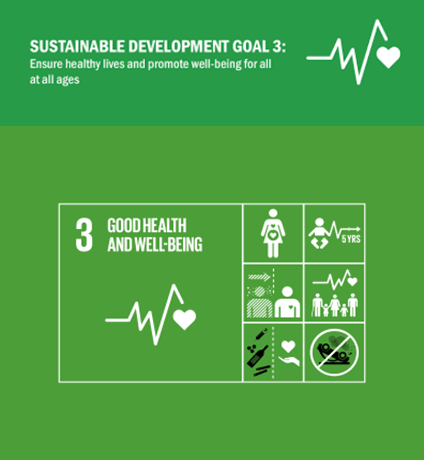 As per World Health Organisation (WHO) Constitution, 1946, the Right to Health is the right to the enjoyment of the highest attainable standard of physical and mental health. The right to health has been enshrined in our Constitution indirectly as -
As per World Health Organisation (WHO) Constitution, 1946, the Right to Health is the right to the enjoyment of the highest attainable standard of physical and mental health. The right to health has been enshrined in our Constitution indirectly as -
- Article 15: The right to equality upholds non-discrimination at the hands of the government on the basis of religion, race, caste, gender, place of birth, etc.
- Article 21: The judicial interpretation of the right to life and personal liberty under this Article as inclusive of health has been crucial.
- Article 38: This Directive Principle of State Policy provides for the duty of the state to promote welfare of its people and elimination of inequalities in facilities.
- Article 47: This Directive Principle states to improve public health.
What is the Indian government doing to ensure the Right to Health for all?
- Ayushman Bharat - National Health Protection Mission, 2017 was introduced to cover over 10 crore poor and vulnerable families to achieve the vision of Universal Health Coverage. It has two interrelated components –
- Pradhan Mantri Jan Arogya Yojana (PM-JAY) -
- It has a defined benefit cover of 5 lakh per family per year.
- Benefits of the scheme are portable across the country with cashless benefits.
- It is an entitlement based scheme with entitlement decided on the basis of deprivation criteria in the SECC database.
- The beneficiaries can avail benefits in both public and empanelled private facilities.
- Health and Wellness Centres (HWCs) –
- Under ‘Ayushman Bharat-HWCs’, states are upgrading PHCs to HWCs across rural and urban areas.
- National Digital Health Mission (NDHM) is supported by an ecosystem to provide Universal Health Coverage in an efficient and inclusive manner.
- Pradhan Mantri Jan Arogya Yojana (PM-JAY) -

Source:
https://timesofindia.indiatimes.com/india/rural-folks-have-equal-right-to-healthcare-as-city-dwellers-sc/articleshow/97293732.cms?from=mdr
Taxing agricultural income - Edukemy Current Affairs
In News
Exemptions and non-taxation of agricultural income are the two main reasons leading to a reduction in the number of people who submit income tax returns and the number of people who pay income taxes in India. With a country of India’s size, both these figures should be higher.
About the News
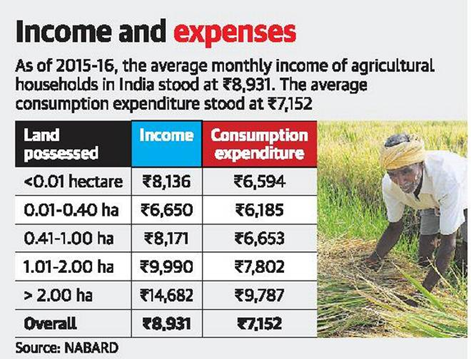
Section 2 (1A) of the Income Tax Act defines agricultural income as rent/revenue from land, income derived from this land through agriculture and income derived from buildings on that land.
- Entry 82 in the Union List mentions taxes other than agricultural income, while Entry 46 in the State List mentions taxes on agricultural income. Hence, agricultural income is part of the State Budgets.
- Section 10 (1) of the Income Tax Act excludes agricultural income from a computation of total income.
- 45% of the labour force is employed in agriculture. This large section of people do not pay any taxes.

- Agriculture income is not taxed because of a general consensus that farmers are poor and that farm households are under heavy debt.
- However, it can not sustain the economy for long. There is a need to tax agricultural income, if above a certain threshold. The poor will be exempt, regardless of whether they are in agriculture.
Why should Agricultural income be taxed?
- Historical reason:
- James Wilson, the first Finance Member of the Viceroy’s Executive Council, introduced the Income Tax Act of 1860. The 1860 legislation taxed agricultural income, above a threshold. The farmers are better off now than the 1860s and are provided much more support by the government than the erstwhile British government.
- Similar statutes already exist in states:
- For example, the Agricultural Income Tax Acts in Bihar (1938), Assam (1939), Bengal (1944), Orissa (1948), Uttar Pradesh (1948), Hyderabad (1950), Travancore and Cochin (1951), Madras and Old Mysore State (1955). Many states retain these statutes and their successors.
- Recommended by committees:
- Report of the Taxation Enquiry Commission (1953–54),
- Raj Committee on Taxation of Agricultural Wealth and Income (1972),
- Fourth Five-Year Plan (1969–74),
- Report of Fifth Finance Commission (1969),
- Tax Reforms Committee (1991),
- Kelkar Task Force on Direct Taxes (2002),
- White Paper on Black Money (2012) and
- Tax Administration Reform Commission (2014).
- To curb money laundering:
- Non-agricultural income is laundered as agricultural income and consequently tax evasion takes place.
- Laundering is not only done by individual farmers but also by the corporate sector.
- This is facilitated even more because of the lack of credibility about the way states issue “farmer” certificates.
- Not taxing agriculture income is violation of horizontal and vertical equity principles:
- Horizontal equity is the principle that taxpayers with equal income should pay equal tax.
- Vertical equity requires that tax obligations vary in proportion to income such that if A has a greater income than B, A will owe more income tax than B.
- Uproot vote bank politics:
- As the Green Revolution spread, a pressure group of large farmers rose to create political clout. Agricultural prosperity, not penury, led to agriculture not being taxed. As in other areas of agricultural policy, policies that benefit large farmers started to masquerade as policies for farmers.
Source:
https://www.newindianexpress.com/opinions/2023/jan/21/the-necessity-of-taxing-farmers-income-in-india-2539771.html
Geothermal Energy -ONGC TO MAP INDIA’S GEOTHERMAL RESOURCES
In News:
- Recently, the state-run oil and gas producer Oil and Natural Gas Company (ONGC) proposed to map India's geothermal resources in search of clean energy. Move comes at a time when India has set an ambitious target of 500 GW of installed renewable energy capacity by 2030 and net zero carbon emission by 2070.
About the News:
- Geothermal energy is stored in the form of heat beneath the earth's surface and is considered clean, renewable, and carbon-free.
- India has an estimated potential of 10 GW of geothermal energy.
- According to studies, Ladakh has been identified as the most resource-rich region in terms of geothermal energy in India.
- ONGC has previously worked on geothermal energy in Ladakh but now plans to conduct surveys across the country.
- Efforts are also under way to utilize geothermal energy from oil and gas wells in Gandhar oil field of ONGC's Ankleshwar asset in Gujarat.
|
What are Geothermal resources?
|
Locations identified are:
- As per preliminary investigations undertaken by the Geological Survey of India, there are around 300 geothermal hot springs in India.
- Puga and Chumathang in eastern Ladakh are the most promising geothermal sites.
- Other sites include Cambay in Gujarat, Tattapani in Chattisgarh, Khammam in Telangana & Ratnagiri in Maharasthra.
Advantage and Disadvantages of the Geothermal Energy:
- Benefits of Geothermal: carbon-free, renewable, provides a continuous, uninterrupted supply etc.
- Disadvantages: location-specific energy source, associated with other emissions like sulphur dioxide and hydrogen sulphide, causes mini tremors in area of operation, high initial cost etc.
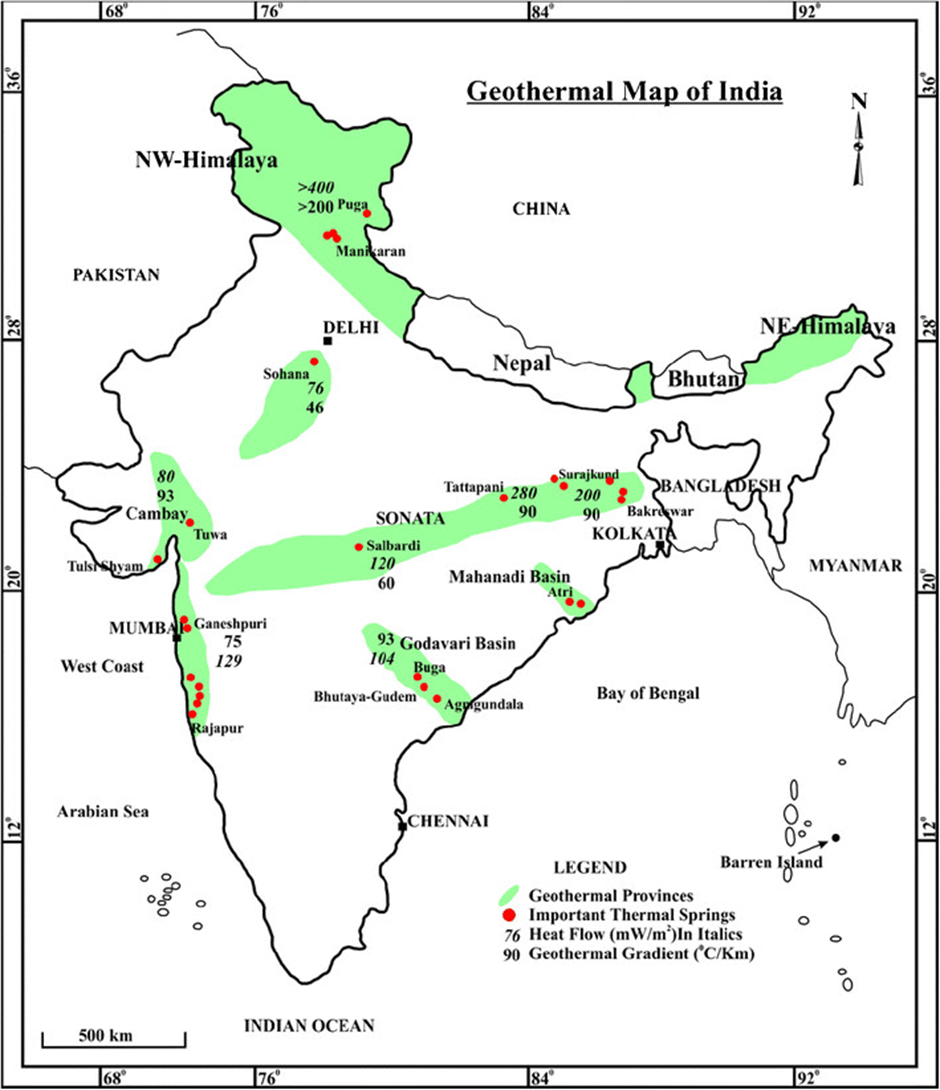
https://www.livemint.com/companies/news/ongc-to-map-india-s-geothermal-resources-in-search-of-clean-energy-11674581979314.html
Sky Glow - Dark Sky Reserves - Edukemy Current Affairs
In News
- Six hamlets within the Changthang Wildlife Sanctuary in Ladakh were designated “dark-sky reserve” – an area whose skies were free of light pollution or sky glow.
About:
- World Atlas of Night Sky Brightness, a computer-generated map based on thousands of satellite photos, was published in 2016 and pointed to light pollution as a global phenomenon.
- Sky glow is the brightening of the night sky, mostly over urban areas.
- It is due to the electric lights of cars, streetlamps, offices, factories, outdoor advertising, and buildings, turning night into day for people who work and play long after sunset.
- More than 80 percent of the world’s population is affected by skyglow phenomena.
- The European Space Agency revealed that the LED lighting revolution throughout the world accelerated light pollution.

Effects of Sky Glow
- It disturbs the circadian rhythm in humans.
- It alters migration patterns for many animals.
- It leads to massive wastage of energy.
Sources:
https://www.thehindu.com/sci-tech/science/the-dark-sky-is-a-natural-resource-and-too-much-light-is-polluting-it/article66423147.ece
https://education.nationalgeographic.org/resource/light-pollution
Charaideo Maidams in Assam - Edukemy Current Affairs
In News
- The Centre has decided to nominate Assam’s Charaideo Maidams — the Ahom equivalent of the ancient Egyptian pyramids — for the UNESCO World Heritage Site.
About

- The Charaideo Maidams are symbolic of the late medieval (13th-19th century CE) mound burial tradition found in Tai Ahom community in Assam.
- The Ahom rule lasted for about 600 years until the British annexed Assam in 1826.
- Charaideo, more than 400 km east of Guwahati, was the first capital of the Ahom dynasty founded by Chao Lung Siu-Ka-Pha in 1253.
- It enshrines the mortal remains of the members of the Ahom royalty, who used to be buried with their paraphernalia.
- After the 18th century, the Ahom rulers adopted the Hindu method of cremation and began entombing the cremated bones and ashes in a Maidam at Charaideo.
Also, read
Source:
https://www.thehindu.com/society/history-and-culture/pyramid-like-ahom-burial-mounds-to-be-indias-nomination-for-unesco-world-heritage-site-tag/article66416742.ece
Nidhi companies - Edukemy Current Affairs
Why in news? Recently, Government has now made it mandatory for Nidhi companies to inform the authority about changes in control of the organization.
About:
- Nidhi Company is a type of Non-Banking Finance Company (NBFC) formed with the primary object of inculcating saving habits among its members and works on the principle of mutual benefit.
- They don’t require a license from RBI, but RBI can issue directions to them on deposit-taking activities.
- Registered under the Companies Act, they are regulated by the Ministry of Corporate Affairs for operational matters.
- They are controlled by Nidhi Rules, 2014.
- Nidhi Company can’t deal with chit funds, hire-purchase finance, leasing finance, insurance or securities business.
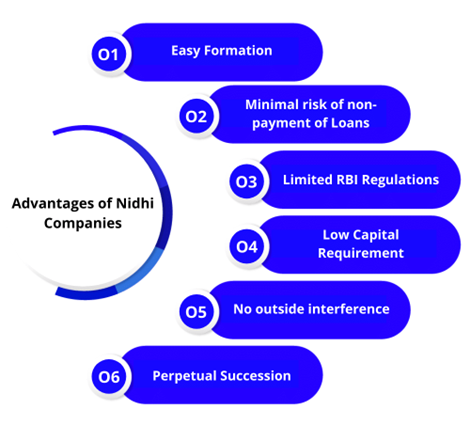
https://www.thehindubusinessline.com/money-and-banking/nidhi-companies-needs-to-give-more-disclosers-inform-about-change-in-controlacquisition/article66428113.ece
Tele Manas - Edukemy Current Affairs
Why in news? Recently, The Department of Health and Family Welfare has initiated ‘Tele Manas’, a teleconsultation service, to address mental health issues.
About:
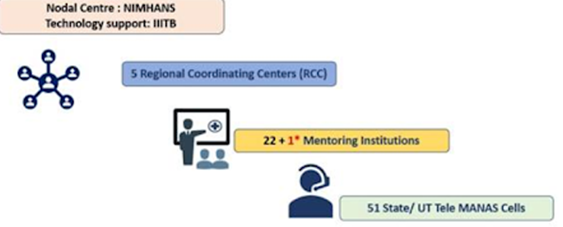
- Its objective is to provide free tele-mental health services all over the country round the clock, particularly catering to people in remote or under-served areas.
- NIMHANS is the nodal centre and International Institute of Information Technology-Bangalore (IIITB) providing technology support.
- Tele-MANAS will be organised in two tier system.
- Tier 1 comprises of state Tele-MANAS cells which include trained counsellors and mental health specialists.
- Tier 2 will comprise of specialists at District Mental Health Programme (DMHP)/Medical College resources for physical consultation and/or e-Sanjeevani for audio visual consultation.
https://www.thehindu.com/news/national/andhra-pradesh/tele-manas-launched-to-address-mental-health-issues/article66429018.ece
Methanol Blended Diesel - Edukemy Current Affairs
Why in news? Recently, Demo-run of Vessel named SB Gangadhar in Guwahati, Assam was held in run-up to India Energy Week 2023 (IEW 2023).
IEW 2023, first major event under India's G20 Presidency, follows PM’s pledge at COP26 to cut India's emissions to net-zero by 2070. IEW 2023 is held under Ministry of Petroleum & Natural Gas.
 About:
About:
- Methanol is a low carbon hydrogen carrier fuel produced from high ash coal, agricultural residue, CO2 from thermal power plants and natural gas.
- Although slightly lower in energy content than petrol and diesel, methanol can replace both these fuels in the transport sector (road, rail and marine), energy sector and retail cooking.
- Blending of 15% methanol in gasoline can result in at least 15% reduction in the import of gasoline/crude oil.
- In addition, this would bring down GHG emissions by 20% in terms of particulate matter, NOx, and SOx, thereby improving the urban air quality.
- Methanol is a cost-effective alternative marine fuel.
https://pib.gov.in/PressReleasePage.aspx?PRID=1893191
SC judgements to be available in 4 languages
Why in news? Chief Justice of India (CJI) stated that judgments delivered by Supreme Court (SC) will now be translated into four languages —Hindi, Tamil, Gujarati and Odia.
About:

- CJI said that move will help in the access to justice for the citizens as English is not a
comprehensible language to majority of the citizens in the country.
- CJI also launched an Online e-Inspection Software at Delhi High Court that will facilitate online e-inspection of digitized judicial files through the internet.
https://www.hindustantimes.com/cities/delhi-news/sc-judgments-to-be-now-available-in-4-languages-says-cji-101674588729524.html
Estonia - Edukemy Current Affairs
Why in news? Recently, Russia expelled Estonia's Ambassador and downgrades their diplomatic relations.
About:

- It is a country in north-eastern Europe, northernmost of three Baltic states (the other two are Latvia and Lithuania).
- It shares a border with Russia and Latvia.
- East Estonia is bounded by Russia—predominantly by the Narva River and Lakes Peipus.
- South part is covered with moraine hills, and the central part of the country abounds in elongated hills with flat tops.
- Important rivers: Pärnu (longest), Pedja, Narva, and Kasari.
- Highest peak: Suur Munamägi (Great Egg Hill).
https://www.bbc.com/news/world-europe-64372508
Immune Imprinting - Edukemy Current Affairs
Why in news? Recently, Scientific studies have found that immune imprinting can make bivalent boosters less effective.
About:

- Immune imprinting is a tendency of the body to repeat its immune response based on the first variant it encountered through infection or vaccination — when it comes across a newer or slightly different variant of the same pathogen.
- Concept of immune imprinting came to light for the first time in 1947.
- Bivalent boosters are variant specific booster shots of vaccines to develop better immunity against coronavirus.
- Imprinting acts as a database for immune system, helping it put up a better response to repeat infections.
- This makes the variant specific booster dose less effective.
https://indianexpress.com/article/explained/explained-health/immune-imprinting-boosters-effective-explained-8397721/
Share the article
Get Latest Updates on Offers, Event dates, and free Mentorship sessions.

Get in touch with our Expert Academic Counsellors 👋
FAQs
UPSC Daily Current Affairs focuses on learning current events on a daily basis. An aspirant needs to study regular and updated information about current events, news, and relevant topics that are important for UPSC aspirants. It covers national and international affairs, government policies, socio-economic issues, science and technology advancements, and more.
UPSC Daily Current Affairs provides aspirants with a concise and comprehensive overview of the latest happenings and developments across various fields. It helps aspirants stay updated with current affairs and provides them with valuable insights and analysis, which are essential for answering questions in the UPSC examinations. It enhances their knowledge, analytical skills, and ability to connect current affairs with the UPSC syllabus.
UPSC Daily Current Affairs covers a wide range of topics, including politics, economics, science and technology, environment, social issues, governance, international relations, and more. It offers news summaries, in-depth analyses, editorials, opinion pieces, and relevant study materials. It also provides practice questions and quizzes to help aspirants test their understanding of current affairs.
Edukemy's UPSC Daily Current Affairs can be accessed through:
- UPSC Daily Current Affairs can be accessed through Current Affairs tab at the top of the Main Page of Edukemy.
- Edukemy Mobile app: The Daily Current Affairs can also be access through Edukemy Mobile App.
- Social media: Follow Edukemy’s official social media accounts or pages that provide UPSC Daily Current Affairs updates, including Facebook, Twitter, or Telegram channels.





